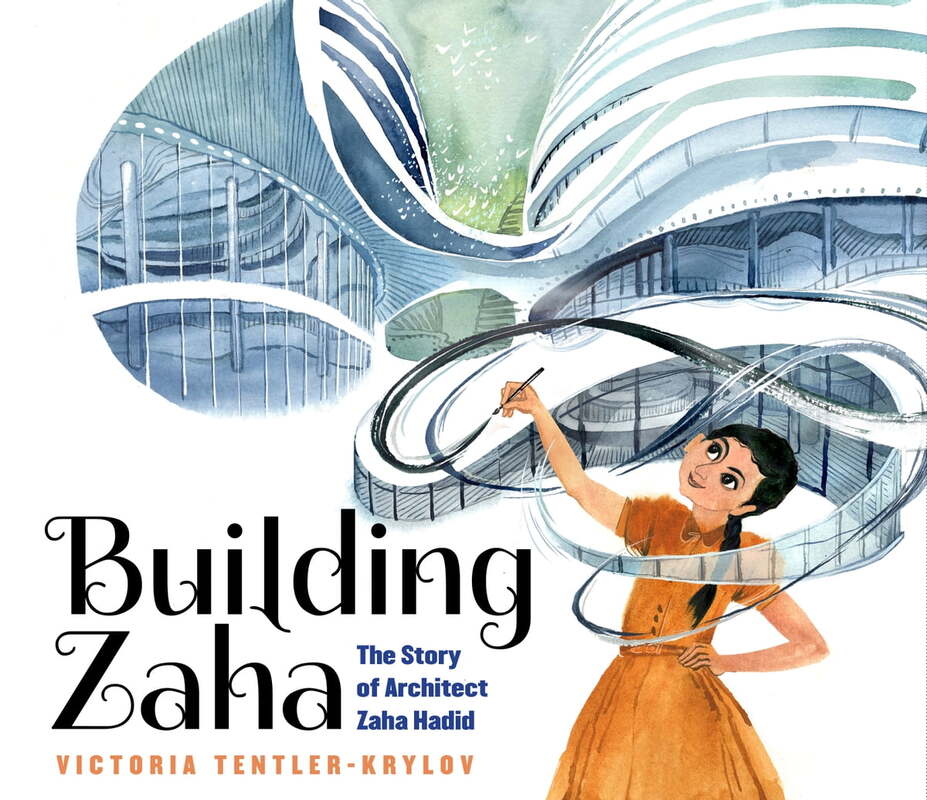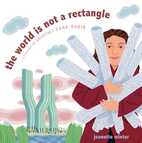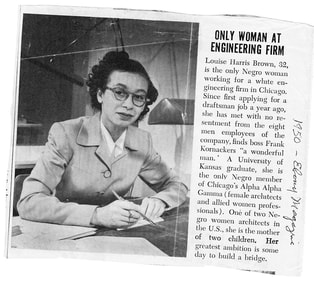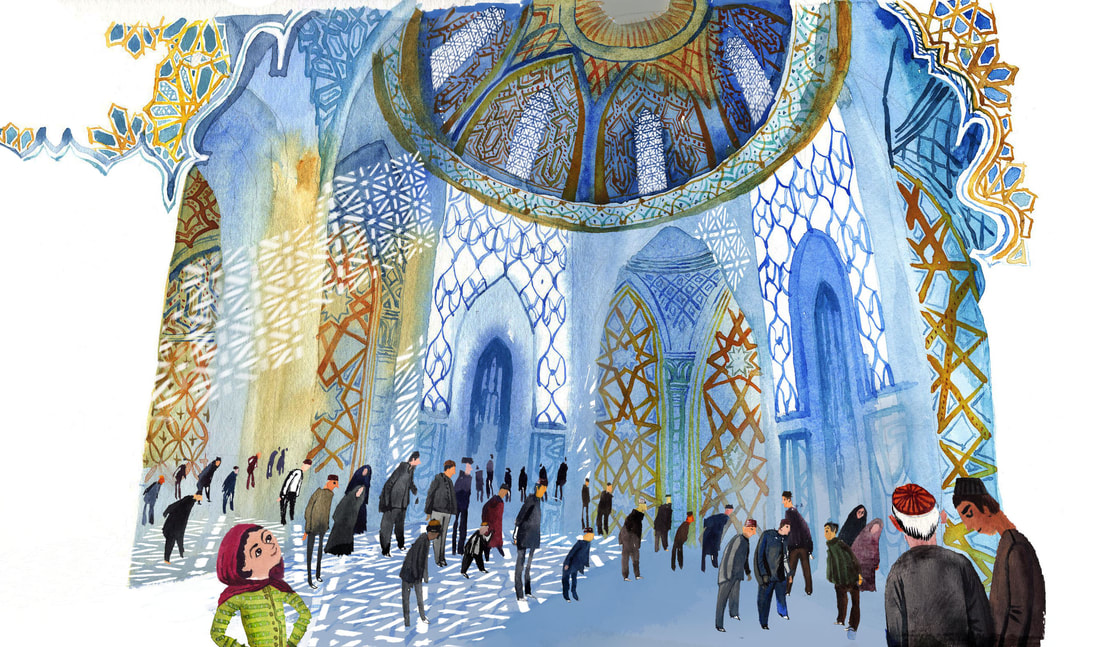|
Entry written by Julie Waugh and Erika Thulin Dawes, on behalf of The Biography Clearinghouse.
|
Research & Writing ProcessWho is Victoria Tentler-Krylov?
Victoria is a trained and practicing architect, as well as a children's and editorial illustrator, who grew up in Saint Petersburg, Russia, and studied architecture and urban design at Cooper Union and Columbia University. Her inspiration is fueled by urban landscapes but also by fantasy, possibility, and imagination. Her other passion is experimenting with digital and traditional art tools... and in particular, pushing the boundaries of watercolor digitally. Find out more about Victoria on her website.
|
Victoria's Process & Artifacts
|
Watch the video to learn more about Victoria’s process of writing and illustrating, specifically:
|
|
Craft & Structure
Characterization in Biography
Zaha Hadid was known for her striking physical presence and unique sense of style. She was also known for her focus, determination, and perseverance. Engage your students in a conversation about how Victoria Tentler-Krylov uses text and illustration in Building Zaha in order to convey Hadid’s individuality and uniqueness.
After a first reading of the text, ask students to describe Zaha Hadid and record the phrases and character traits that they name. Follow this with a close reading of the text, guiding students to notice words and phrases that convey her character. Reread with a focus on the illustrations, asking students to describe how the visual images let readers learn about Zaha’s characteristics. Students can record their observations about text and image and how they convey character on a two-column chart. Connect student observations with a discussion of author’s craft, noting how authors of biography strategically build characterization through: descriptions of the actions of the subject, descriptions of the subject’s interactions with others, direct quotes from the subject, and statements about the subjects’ motives and thoughts that are inferred from and backed by research.
Listen to the Biography Clearinghouse interview to learn more about how Victoria Tentler-Krylov composed and illustrated with the goal of sharing Zaha Hadid with young readers. (7 min Zaha’s personal style; 12:30 min representing Zaha’s childhood; 28 min illustrations and character development).
After a first reading of the text, ask students to describe Zaha Hadid and record the phrases and character traits that they name. Follow this with a close reading of the text, guiding students to notice words and phrases that convey her character. Reread with a focus on the illustrations, asking students to describe how the visual images let readers learn about Zaha’s characteristics. Students can record their observations about text and image and how they convey character on a two-column chart. Connect student observations with a discussion of author’s craft, noting how authors of biography strategically build characterization through: descriptions of the actions of the subject, descriptions of the subject’s interactions with others, direct quotes from the subject, and statements about the subjects’ motives and thoughts that are inferred from and backed by research.
Listen to the Biography Clearinghouse interview to learn more about how Victoria Tentler-Krylov composed and illustrated with the goal of sharing Zaha Hadid with young readers. (7 min Zaha’s personal style; 12:30 min representing Zaha’s childhood; 28 min illustrations and character development).
Biography Subjects as Mentors
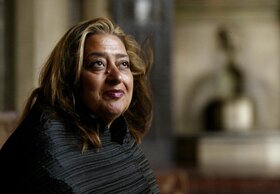 Zaha Hadid (Photo: AP)
Zaha Hadid (Photo: AP)
In her Author’s Note, Victoria Tentler-Krylov describes how at the age of two, she began drawing unusual-looking houses and how this early interest led to her studies in architecture. Zaha Hadid’s work was inspirational to Victoria and the Author’s Note includes a bulleted list of what she learned by watching the progress of Zaha’s career. Although Victoria never spoke with Zaha Hadid, Zaha served as a mentor to her, and in composing and illustrating Building Zaha, Victoria hopes to extend this mentorship to young readers.
Invite your students to consider how the genre of biography puts readers in relationship with the person who is the subject of the biography. As you read biographies in your classroom over the course of the year, ask students to make note of what they learn from the people who are the subject of the biographies, students can record their learning in their reading journal or in a special journal dedicated to this purpose.
Invite your students to consider how the genre of biography puts readers in relationship with the person who is the subject of the biography. As you read biographies in your classroom over the course of the year, ask students to make note of what they learn from the people who are the subject of the biographies, students can record their learning in their reading journal or in a special journal dedicated to this purpose.
Content & Disciplinary ThinkingArchitecture Inspired by NatureIn Building Zaha, Tentler-Krylov shares how an early visit to see The Marsh Arabs of Southern Iraq with her father became an important and notable influence for Zaha that would later affect her architecture. Many believe that The Marsh Arabs are descendents of some of the first people, the ancient Sumerians. Residents of this unique region of Iraq built structures called Mudhif out of the reeds and straw of the surrounding marsh. The peaceful relationship of place, structures and people struck Zaha in this early trip. Building Zaha prompts readers to observe their surroundings and consider questions such as:
|
 Cholla Cactus
Cholla Cactus
How can humans live in harmony with nature?
How can human structures be inspired by nature?
How can human structures be inspired by nature?
- Invite readers to look at examples of architectural structures that are influenced by the land around them and use local materials, such as adobe homes of the Southwest United States, or the saltbox homes of New England.
- Play with looking at structures from nature. Brainstorm elements in nature we could use to inspire architecture. Go for a walk in a local habitat and observe the natural structures in your local ecosystem.
- For example, in the desert ecosystem in Mesa, AZ, this is a cactus wren’s nest in a cholla cactus. What would Zaha learn and be inspired by that she could incorporate into a building? What ideas do students have about how this natural structure could inspire them as architects and designers? Consider using this photo, or a natural element that someone notices on a walk to talk about and brainstorm the ways that natural elements can inspire architects and designers.
- Look at some of Zaha’s building designs with students (resources below) and ask “What in nature could have influenced Zaha when she created this building?”
- For example, the Saudi Aramco King Abdullah Petroleum Studies and Research Center In Saudi Arabia, finished after Zaha Hadid’s death in 2016, used research based on sponges, leaves, and reptile skins to create the design for the building.
Iraq
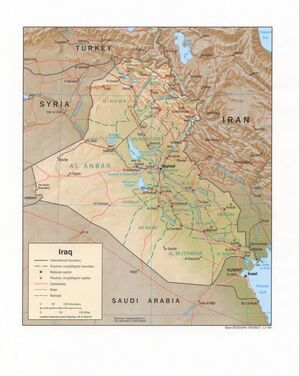 Iraq Map (Library of Congress)
Iraq Map (Library of Congress)
Zaha Hadid was born in 1950 and grew up in Iraq during one of its most prosperous and forward-looking times in recent history. Zaha saw modern buildings rise around her. Creativity, growth, and education were fundamental parts of her life. The rule of Saddham Hussein beginning in 1979, the Gulf War with the United States, and the subsequent UN sanctions changed the learning landscape that Zaha knew as a child in Iraq. By this time, Zaha Hadid was living in Europe, and later made her home in London.
Under the rule of Saddham Hussein, even the Marsh Arabs of Zaha’s influential childhood memories were jeopardized when the marshes were drained because the water from the Tigris and Euphrates rivers were diverted. The local Madan people were relocated to areas adjacent to the former marshes. Fortunately, since 2003, there has been an effort to restore the marshes, and return the people who called it home.
What ideas and conceptions do your students hold about the country of Iraq? Expand their understandings with the following resources.
Under the rule of Saddham Hussein, even the Marsh Arabs of Zaha’s influential childhood memories were jeopardized when the marshes were drained because the water from the Tigris and Euphrates rivers were diverted. The local Madan people were relocated to areas adjacent to the former marshes. Fortunately, since 2003, there has been an effort to restore the marshes, and return the people who called it home.
What ideas and conceptions do your students hold about the country of Iraq? Expand their understandings with the following resources.
Childhood Experiences and the Lives We Want to Live
It was important to Victoria Tentler-Krylov to focus on Zaha Hadid’s earlier life and the experiences that helped make her the visionary architect she became. Zaha’s visit to see the Marsh Arabs was one of the “seeds” that was planted in her and grew into larger and wonderful ideas when she became an architect. Barb Rosenstock similarly focused on Frank Lloyd Wright’s childhood in her book Prairie Boy.
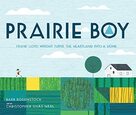
For Frank Lloyd Wright, it was exploration with line and color and building toys, the Froebel blocks, which influenced his own architecture. A paired read of these two texts could frame an inquiry into the earlier experiences that influenced famous architects, and prompt students to think about possible sources of inspiration in their own lives.
It can be difficult to recognize, in the moment, experiences in life that will later be influential. It may be interesting to ask students about moments from their lives that linger with them and make predictions how they may influence their later lives. Invite students to write in response to this question: “What is an experience or image from your childhood that is stuck in your mind and made a great impression on you?”. Then challenge them to write about “How do you think this image or experience could inspire or influence you as a professional?” We imagine that you may find some of the students’ responses inspirational and insightful.
Exploring Zaha's Designs
Zaha Hadid became known as “the queen of the curve” in the architecture world. She created buildings with shapes that people thought impossible to build. Invite students to explore, notice, and wonder with Zaha Hadid’s amazing projects:
- A Tour of Zaha Hadid’s Most Iconic Buildings from Google Arts and Culture
- 30 Projects That Define Zaha Hadid’s Style from Rethinking the Future
- At her death, the BBC created this short video that looks back on Zaha’s work.
- For a slightly longer look at her life, watch Curious Muse’s Zaha Hadid in 7 Minutes.
- Google Arts and Culture also has a site Zaha Hadid; Groundbreaking Architect and Visionary.
|
Another recent children's book biography about Zaha Hadid is The World is Not a Rectangle by Jeanette Winter. Winter’s book focuses on how Zaha Hadid’s work is influenced by the natural world, whereas Tentler-Krylov’s book focuses more on Zaha the person. The paired texts can provide a powerful invitation for students to compare and contrast the different ways in which authors made choices about how to share a person’s life in picture book format.
|
Breaking Boundaries: Female Architects
Throughout her career, Zaha Hadid encountered stumbling blocks. In the Biography Clearinghouse interview, Victoria Tentler-Krylov describes how her research into Zaha’s life revealed that Zaha wondered how those obstacles related to her identities as a woman and as a Muslim. Women continue to be underrepresented in the field of architecture. After reading Building Zaha, introduce your students to the work of Maya Lin, by reading Maya Lin: Artist-Architect of Light and Lines (written by Jeanne Walker Harvey, illustrated by Dow Phumiruk, Henry Holt 2017). Compare and contrast the lives, experiences, and accomplishments of these two renowned female architects. Extend your study of women in architecture, by exploring the digital resources below. Connect with a female architect in your community who is willing to share her experiences in the field with your students.
|
Women of Steel and Stone
https://www.archute.com/top-female-architects/ 15 Architects of Being Black in Architecture https://www.culturedmag.com/article/2020/08/06/15-architects-on-being-black-in-architecture Early Black Female Architects https://www.madamearchitect.org/in-ink/2021/1/29/that-most-exceptional-one-early-black-female-architects |
The Power of Interviews
|
Victoria Tenler-Krylov explained that it was watching the many available interviews with Zaha Hadid that gave her the most information about Zaha’s life. Interviews, both conducting them and watching them, are a powerful way to conduct research, and provide one of the best primary sources for learning about someone’s life. Inviting students to plan, conduct, and publish interviews is an authentic and worthwhile engagement.
|
Consider the following engagements to
|
Social & Emotional Learning
Goal Setting
|
The title page of Building Zaha: The Story of Architect Zaha Hadid includes a quote from Zaha herself: “You really have to have a goal. The goal posts might shift, but you should have a goal.” Reread the book with this quote in mind; discuss how Zaha experienced obstacles and setbacks that required her to adjust, and how she persevered with her designs and her goals. Victoria Tentler-Krylov discusses this in the Biography Clearinghouse interview at the 19:30 time marker and then again at the conclusion of the interview. She describes how Zaha Hadid remained true to her ideas, demonstrating confidence in her work even when others questioned whether her designs were buildable.
|
Ask your students to consider the goals that they currently hold for themselves. Depending on the age of your students, you may ask them to consider both short term and longer term goals. Ask students to document these goals, either in writing or in illustration and to begin to think about how they will achieve these goals. What do they need to learn or to practice? Who can help them? How can they measure their progress? What will they do when they encounter challenges?
|
New Texts & ArtifactsDesigning for Form and Function: Thinking Like an ArchitectVictoria Tentler-Krylov shared how one of her favorite illustrations in Building Zaha is the spread where a young Zaha is the only character in a crowded space who is looking up in a beautiful mosque. Looking closely and wondering can help you think and work like an architect. Looking closely and wondering can also help you focus on form (what a space looks like) in architecture, and how well that form meets function (what is going to happen in the designed space). Form and function are ideas that need to work hand in hand for an architect to create a successful place to live or work.
|
|
Some people told Zaha Hadid that form was more important to her than function. She was criticized that her creative, uniquely designed spaces did not use space as well as they could, or did not use space as efficiently as possible. This was part of why, early in her career, people told Zaha that she would only be a “paper architect” - an architect that would only have designs on paper and not made into buildings.
|
If you have 1-2 hours... |
If you have 1-2 days... |
If you have 1-2 weeks... |
|
Invite students to look closely at your own classroom. What do you notice about how it is formed? How well does the way it is designed help you learn? How could you improve your classroom’s design to make it a better place to learn? Record some ideas and make some initial sketches.
|
Zaha Hadid started many of her earlier architectural plans with paint and brush. After sharing ideas about how the classroom could be improved and redesigned, invite students to use different media (paint, watercolor, markers, crayon, colored pencil) to create initial plans for a newly designed classroom, much the same way that she did. You may wish to share some of Zaha’s initial architectural artwork to inspire them.
|
Zaha Hadid was one of the first people to predict that computers would transform the architectural design process. It is possible that computers allowed her to create some of the unique shapes and structures that many thought were not possible. Collaborate with a local architect who can demonstrate their use of computer programs in their process of design. Visit with the architect in person or by Zoom so that students can see the architect's sketches and final plans. Ask questions about how the architect considers form and function in their design.
Discuss how plans become blueprints that serve as guides for the construction of a building. Invite your students to revisit the initial classroom design plans they created with an eye for the relationship between form and function. How does the structure of the classroom they have created relate to its proposed use? Pair students so that they can describe their classroom plans to a classmate to get feedback. Next, ask students to create a more blueprint-like sketch of their envisioned classroom. Some students may be up for the challenge to use Google Sketch Up to create a structure from its creative beginnings to a model that you can walk through virtually. |
Additional Resources:
- The Guggenheim Museum in New York has the following interesting resources for teachers, with lesson plans, entitled Form Follows Function.
- Article on Zaha - Form and Function: https://www.jetir.org/papers/JETIRC006088.pdf
Thulin Dawes, E., & Waugh, J. (2022). Building Zaha: The Story of Architect Zaha Hadid. The Biography Clearinghouse.

